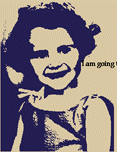|
Sangre Boliviana Lucia Grossberger-Morales
I started this piece many years ago when I first returned to Bolivia, after having emigrated to the United States at the age of 3. There were many lasting impressions from the trip: the compelling barren beauty of the Altiplano, the tenacity of the indigenous people in maintaining their ways, the striking colors of the costumes of the indigenous people, the attachment of the people to the Pachamama (mother earth) and, unfortunately, the underlying racism towards the indigenous people. With each subsequent trip I felt a draw, a pull---as if the ancestors were calling me, compelling me. Their language was not an aural language. It was not something I could hear, rather it was the language of the heart. In Sangre Boliviana, there are nine pieces, plus an introduction. Each of the pieces tells a different story, but also is unique in how the software technology is used. In all cases I let the content of the story dictate the interactive style. Multimedia can be a very powerful medium for interactive story telling and allows the participant to explore information, particularly layered, multichannel information in an engrossing, even playful, way. An example of how I let the story dictate the interactive format is in the story of Cholera 1992 (Fig. 1). In designing this piece, I was inspired by the horror that I felt at the existence of cholera in South America. When I was in Cochabamba, Bolivia, in February 1992, 500 people died of cholera---I could not believe it. I thought cholera had been eradicated. And of course it has been in First-World countries; but there it was in Cochabamba. The piece that grew out of that horror became incorporated into an arcade format. I felt that the only way I could address the topic and express my horror was through the use of black humor. Black humor has historically been used as a way of psychologically dealing with horrific experience. For example, D=A1a de los Muertos was originally a way of coping with the massive number of deaths in Mexico during the time of the conquistadors. Another example of using black humor as a way of coping with horror is the song "Ring Around the Rosies," which was popular during the time of the Black Plague when millions of people were dying of Bubonic plague. In Cholera 1992, the arcade format, with all types of humorous, "sick" scatological references and ironic off-hand writings, was the only way I could think of to address the topic of cholera. Palabritas explores my early relationship with Spanish and the powerlessness and pain that I felt upon moving to the United States where everyone spoke English. The word Huaca is a Quechua word and is very difficult to translate. To understand the meaning of the word one must understand about the culture. Unlike Western culture, where there are dualities---for example good and bad---the indigenous of the culture believe that those dualities are what make something creative. In designing all of life one seeks those dualities to give something beauty. Huaca explores a painful, but also a very rich, creative journey emigrating from Bolivia to the United States. Catavi is a surrealistic interactive "photo album" that shows the processed images from a visit to the town where I was born. Words and test accompany the images. A Mi Abuelita is an interactive narrative about my grandmother and her death. The user sees and hears the story. Clicking on any italicized English word will expand historically on that topic. Clicking on any of the Spanish words will bring on a translation. Oruro is a series of four "interactive video post cards." Oruro is the folklore capital in Bolivia. It is the home of the second largest Mardi Gras celebration in South America. In Bolivia each small region has its own important dances. The most important dance is the Diablada, the dance of the devils. This dance is rich with symbolic meaning about the conquest, region and the attitudes toward the mines. La Chillah is a ritual ceremony thanking Pachamama, mother earth, for the harvest. It is held in the fall right after Mardi Gras. It is a day of feasts, where the people make several offerings. Sangre Boliviana is a CD-ROM for the Macintosh computer. The shell was created in MacroMind Director. The elements were created in Adobe Premier, Adobe Photoshop, Sound Edit and Painter.
|
___________________________________________________________________________________________________
copyright 1995 ISAST
